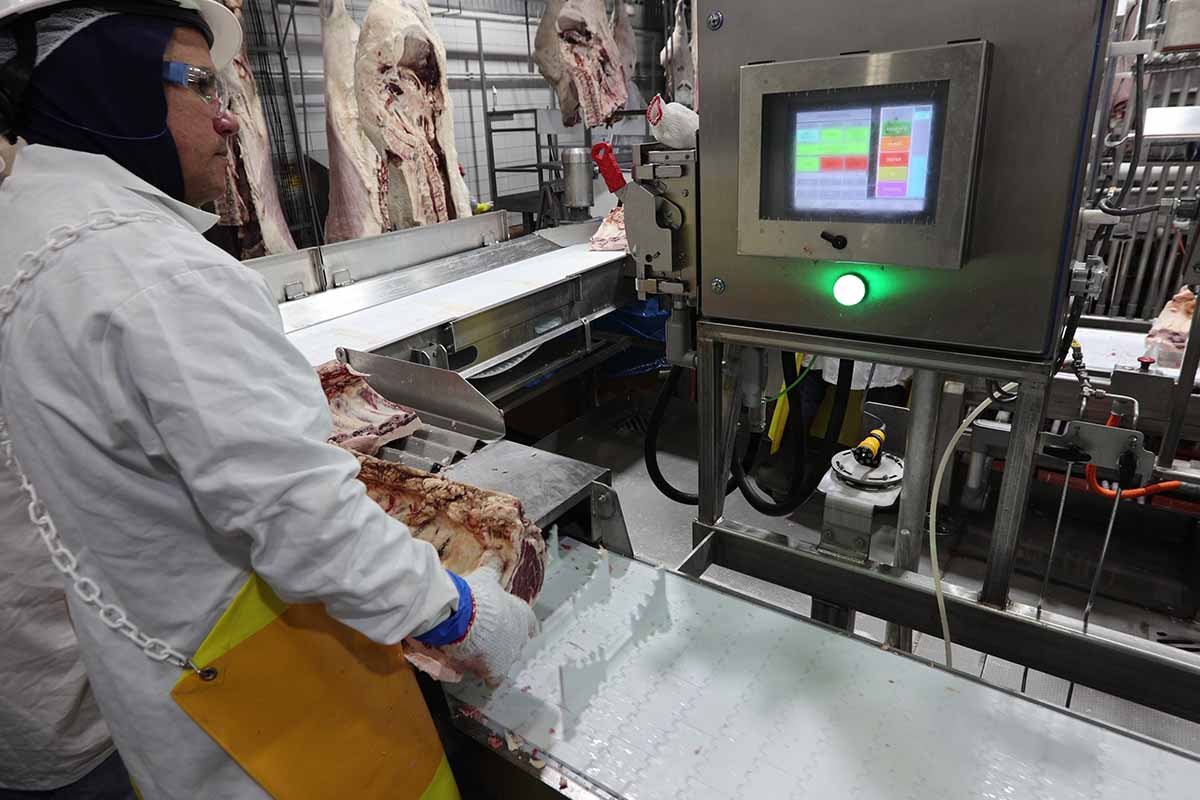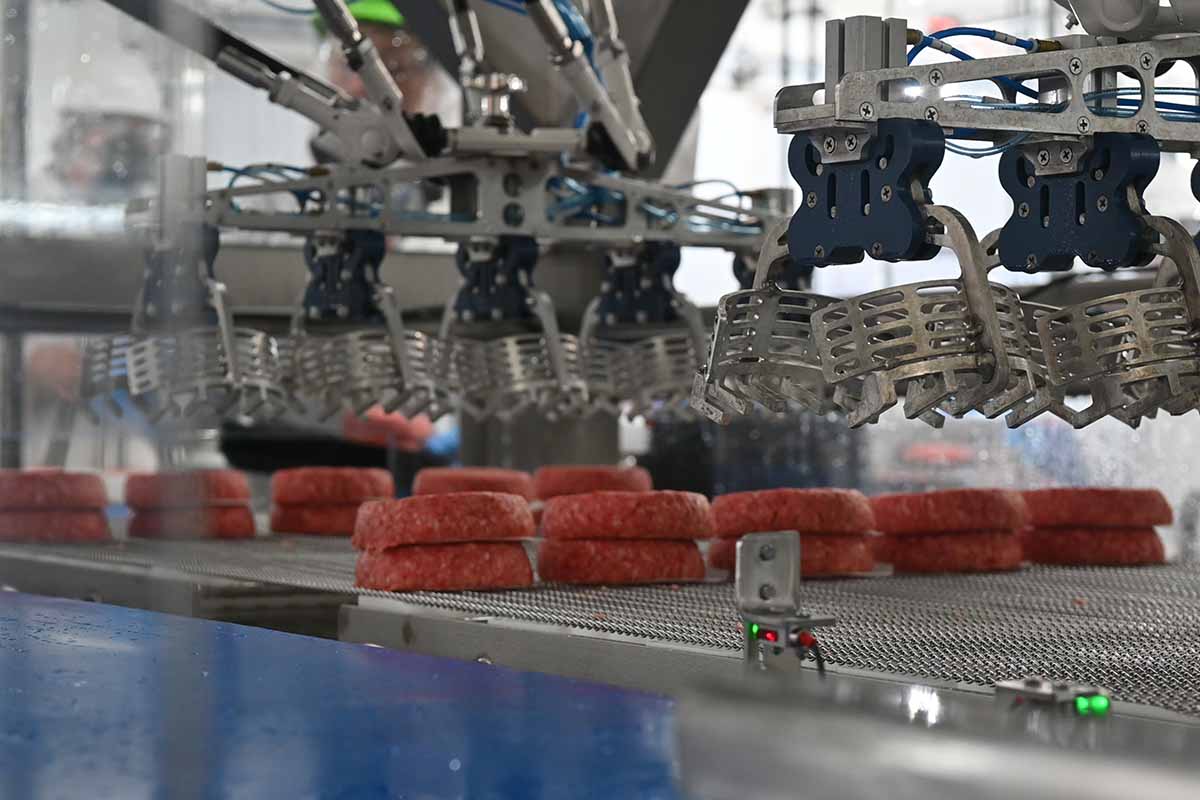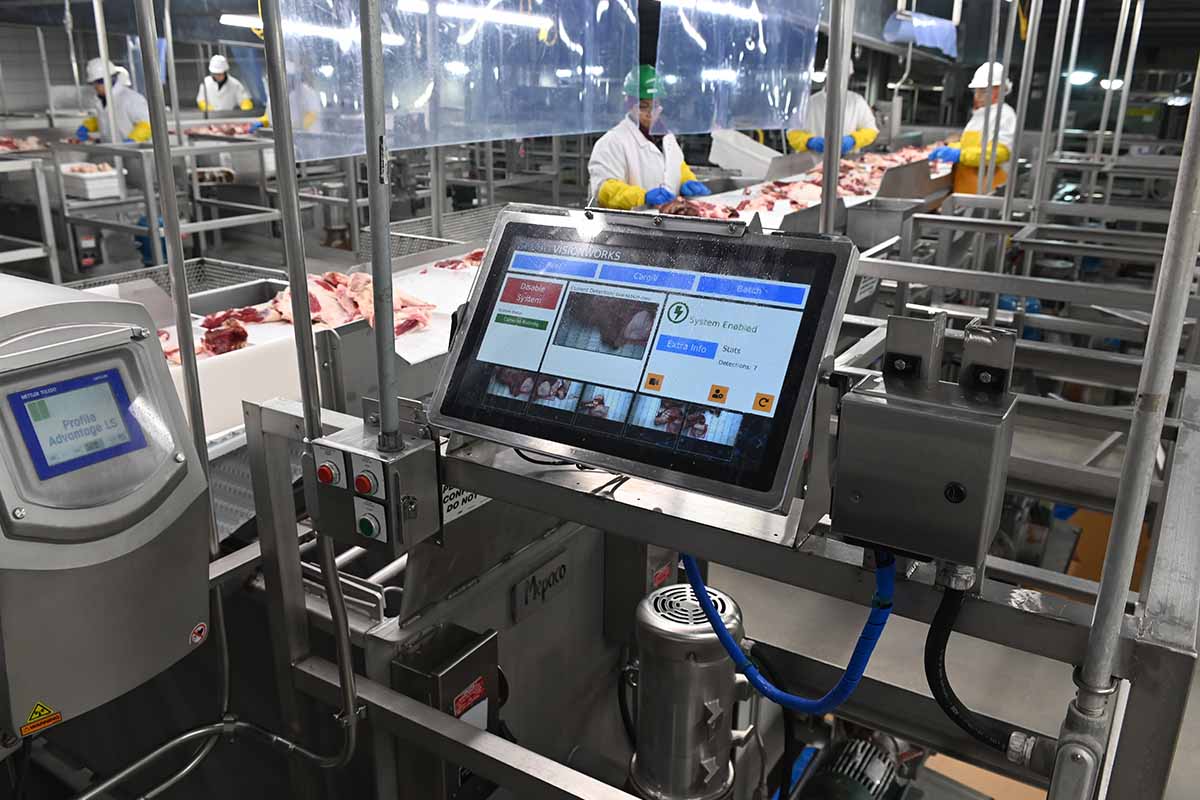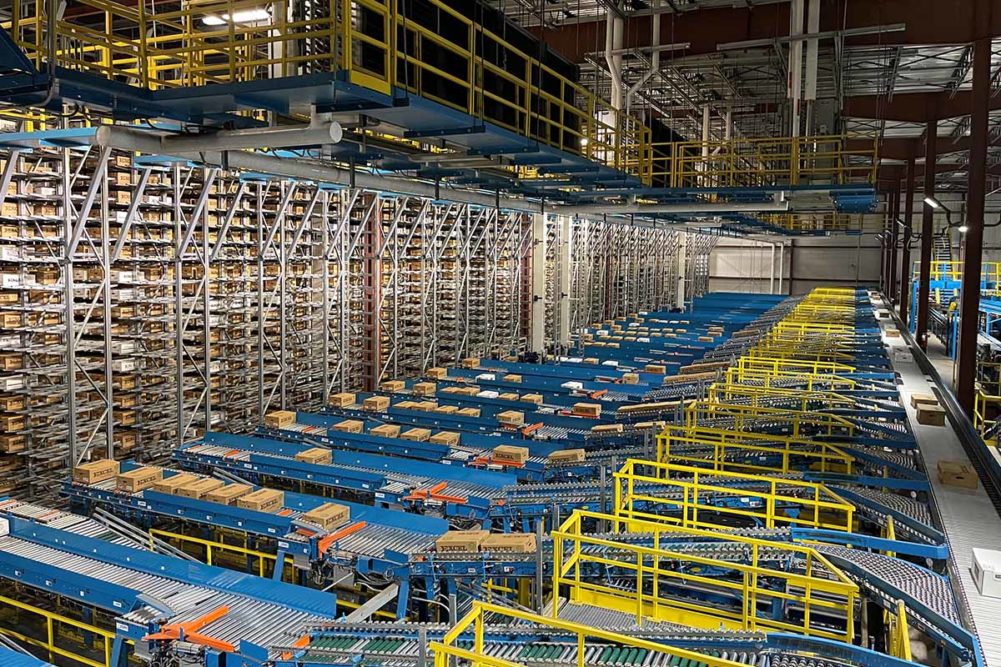Not unlike the trend among homeowners to equip their abodes with smart technology to remotely monitor and control everything from thermostats to door locks to lighting, operators of meat and poultry processing plants are increasingly implementing digital and automated solutions at their facilities to optimize operations and address labor challenges. Indeed, most of the industry’s larger companies are at various stages in converting to and implementing automation, robotics and digital analytics across their operations, but the path to smart manufacturing is a challenging one to navigate and far from a one-size-fits-all scenario.
The genesis of Cargill’s efforts to develop what is now known as the “Facility of the Future” was underway well before 2020, when COVID forced most plants into survival mode, and pushed many ancillary projects to the back burner. For Cargill, the brakes were tapped for its Facility of the Future plans, but parts of the program were launched amid the pandemic as the leadership team was eager to prove its concept and execute changes sooner rather than later. The focus of the program is on three areas: automation, digitalizing the processing floor and advanced analytics. Investment in the Facility of the Future program will top $100 million in 2023. That investment just in Cargill’s protein business segment is expected to top $700 million through 2026.
Cargill has rolled out examples of its Facility of the Future program at multiple plants. They include:
- Smart saws
- Automated rib (and strip) chine saws
- Foreign object detection technology
- Super Comm and Shift Simulation technology
- Automated box handling
- IDEX Boards
- FEWS (Fab Early Warning Detection System)
- Paperless FSQR (Food Safety Quality and Regulatory)
During a recent tour of the sprawling Cargill Primary Beef Facility in Dodge City, Kan., company officials and plant management provided an update on its progress in executing the Facility of the Future program with examples of applications already in place.
Beefed up
Built in 1979, the Cargill Primary Beef Facility is the company’s largest processing plant. It spans 900,000 square feet and employs more than 2,600 workers, including professional butchers, packaging specialists, a distribution team, maintenance technicians, inventory specialists and the management team. Depending on demand, the plant operates on two shifts per day, up to six days per week. Cattle are sourced from producers within about a 150-mile radius of the plant. The slaughtering operation includes approximately 625 workers that begin the process of producing Cargill’s branded beef (including Salt & Sear, Sterling Silver, Angus Pride, Preferred Angus and Rumba Meats), foodservice beef programs (including its Excel, Ranchers Registry and Premium Signature Angus lines) and ground beef for retail and foodservice. The plant’s beef is also used for Cargill’s two US Department of Agriculture-process verified products and for customers requesting Certified Angus Beef (CAB).
In 1982 the plant was expanded to facilitate its beef fabrication operations. Today, more than 1,300 employees work on the fabrication floor, where up to 55,000 boxes of beef are produced each day. The company currently operates 42 meat plants systemwide.
The beef operation includes four ground beef production lines that manufacture millions of pounds of product per week. Each shift, about 45 employees work in ground beef operations, producing chubs and case-ready packages. Case-ready processing includes products that are used for Cargill’s Rumba line targeting the growing number of Hispanic consumers.
 Two recently installed automated chine saw lines eliminated safety risks previously faced by two workers per shift, whose jobs were to push the bulky primal into a bandsaw, by hand. (Source: Cargill)
Two recently installed automated chine saw lines eliminated safety risks previously faced by two workers per shift, whose jobs were to push the bulky primal into a bandsaw, by hand. (Source: Cargill)
Testing ground
Using its biggest operation as the pilot for many of its Facility of the Future initiatives, Cargill officials demonstrated how the plant utilizes a combination of automated equipment, technology and digital analytics to make workers’ jobs easier and safer while streamlining processes, improving yields and delivering logistical solutions.
On the operations side, Jeremy Burr, general manager of the Dodge City plant, said the process of removing the chine bone (or spine) from the rib primal cut of beef, using automated technology from Amarillo, Texas-based Midwest Machine LLC, is a perfect example of a Facility of the Future solution at the Dodge City plant. Two recently installed automated chine saw lines eliminated safety risks previously faced by two workers per shift, whose jobs were to push the bulky primal into a bandsaw, by hand, up to 3,000 times a day on the two lines. That process is now handled using a 3-D vision system that scans the meat to determine the cutting path after it is loaded into a cradle. The meat is then conveyed, hands free, through a horizontally mounted bandsaw that adjusts to achieve the optimum cut. Workers are only needed to load the cradle and no longer risk being injured by the blade as it cuts. In terms of productivity, each Smart Rib Saw has the capacity to make seven to 14 cuts per minute.
Burr said this type of safety-focused automation, which can also improve yields, is game changing.
“Three thousand fewer cuts made by hand per day helps me sleep better at night,” he said.
When implementing food safety and automation solutions, optimized visioning systems are critical for success and nowhere is this truer than Cargill’s foreign object detection (FOD) technology that is an integral part in each step of its ground beef production process and throughout the Facility of the Future food safety applications. The company utilizes detection technology that specializes in providing computer vision systems using artificial intelligence technology to sort products and detect foreign material in the food supply.
The FOD technology is used throughout the Dodge City plant and even in its cooked meats facilities to supplement the detection efforts of people working on the production line. The FOD technology is in addition to x-ray inspection throughout its facilities to detect bones and other foreign material in products.
Computer vision technology is effective, in large part because it identifies what’s not meat, Burr said.
Another Facility of the Future technology being used in the Dodge City plant is its Super Comm and Shift Sim software, which allows managers to optimize each shift’s labor assignments based on the day’s production schedule. Managers are able to input data related to factors such as chain speed, numbers of employees and their levels of training, volume and variety of products scheduled for processing, and the Super Comm provides a snapshot of station assignments and expected production based on that shift’s staffing availability.
Digitalizing the process of assessing each day’s schedule and assigning each line worker to a line position streamlines what previously was accomplished using the plant’s veteran supervisors, who would position workers strategically based on one part: production schedule; one part: scheduled staff and one part: gut feel or instinct from having led hundreds of shifts in the past. The system still requires supervisors to actively interact with workers on the processing floor, including shifting workers to positions for each day’s production. But rather than adjusting on the fly, handheld tablets more efficiently help supervisors and managers direct workers where they are needed.
Super Comm also can provide deeper dives into staffing specifics, including identifying workers who might be coming off vacation time and might need extra time getting their productivity ramped back up after their time off. It can take into account many factors, including experience level of workers at various stations and then generate a predicted chain speed and the approximate stress level of the line workers, based on the workload, type of products and the speed expectation. Managers then can make appropriate adjustments to minimize the stress load or supplement staffing during certain times of the shifts.
An over-arching purpose of Cargill’s Facility of the Future is to promote well-being, which Super Comm and Shift Sim both address. For example, they identify how and where stress on workers can be minimized using data and algorithms generated on a tablet instead of pen and paper on a clipboard.
Another smart manufacturing application implemented at the Dodge City plant is what officials call a smart saw. The operator of the band saw on the back side of the fabrication floor is “wired” to the saw with sensors that will automatically stop the blade within a fraction of a second of when the operator’s hand is detected too close to the blade. This is another way of tapping into technology to optimize worker safety.
The rollout of strategically located IDEX boards has been another Facility of the Future component that gives workers at plants the opportunity to have at-a-glance updates about each shift’s production schedule and goals along with the productivity status across the operation.
 Cargill plans to invest more than $700 million in automation and digitizing its operations in the next three years. (Source: Cargill)
Cargill plans to invest more than $700 million in automation and digitizing its operations in the next three years. (Source: Cargill)
Big box investment
In terms of large-scale automation at Dodge City, its “box building” operation is one of the most significant investments and a long-term success story. In 2015, the company invested about $48 million to add a 62,000-square-foot automated order distribution center, which is the foundation for what exists today. The box storage area has been expanded and refined since then. In 2018, the center was upgraded as Cargill saw the opportunity to have a dramatic impact by automating the storage and retrieval of up to 130,000 boxes of beef produced at the plant. Today, the facility is equipped with 30 automated cranes that zigzag 30 aisles of products stored on multi-storied racks.
Officials estimate that after processing, each carcass processed at Cargill requires between eight and nine boxes to store the variety of products, which compares to five to six boxes produced when the building was first constructed. Previously, storage and retrieval were labor intensive, but Burr pointed out that on most days, just two mechanics are working in what is now approximately a 65,000-square-foot building. The cranes shuttle boxes to one of 18 sorting lanes from Hytrol Conveyors, and the system can handle 90 boxes coming in for storage and 50 boxes going out for shipment per minute.
Burr said the evolution of the box building is an example of Cargill investing in automation based on customer and consumer demand. Because so many SKUs are produced at the plant, orders are more fragmented and fewer customers are requesting multiple pallets of the same products as they are more likely to include a wider variety of products requiring many different boxes.
Evolving into the future
Cade Schoonover, Cargill’s capital leader and a key member of the Facility of the Future team, admitted the company’s implementation of automation applications and robotics was historically somewhat on a hit-or-miss basis. Cargill’s first significant foray into automation was in the late ‘90s and early 2000s and until recently the utilization of automated technology hasn’t exactly been undertaken using a holistic approach.
“We’ve done some things with different robotic suppliers and tried to tackle some of the challenging jobs that we had,” he said.
In 2018 Cargill started pursuing opportunities in smart manufacturing, specifically in the areas of process controls and some digital solutions. While working on its enterprise resource planning (ERP) deployment during that period, Cargill officials worked with some consultants who connected them with some universities that were doing some research in smart manufacturing, robotics and advanced controls.
Those connections resulted in Cargill stakeholders looking at the possibilities and asking questions about what could be, Schoonover said.
“How do we leverage technology to really make an impact on plants, reduce the demand on our people and make some of these very difficult and labor-intensive jobs easier; how do we leverage it for safety, sustainability and food safety?” he said.
Looking to the future of plant operations and implementing automation, the goal has never been how to wipe out the most jobs. To the contrary, the Cargill mindset was that incorporating next-level technology at its processing facilities would allow it to lure the most talented job seekers and ensure a sustainable future. Once Cargill’s team agreed this was the way forward and committed to developing a “Facility of the Future” program for the entire company, they sat down with their university partners to flesh out a plan. Just before the pandemic the group focused its energy on rolling out something different.
“As a group, we said, ‘We need to come up with a holistic plan across all of our businesses to bring what we chose to call the factory or facility of the future,’” Schoonover said. “We wanted it to be something that resonated with the workers on the shop floor and something that could drive people to imagine all that it could be.”
Adding the unforeseen wrinkle of COVID forced the team to pause their planning and gave them additional perspective as it became apparent that the Facility of the Future solutions could address the labor challenges that were exacerbated by the pandemic and brought to light other technologies that could simultaneously streamline beef processing operations. The team agreed that despite COVID, the initiative would move forward. It was July 2021 when the development of the strategy was ready for execution.
“We made a decision as an operations statement,” Schoonover said. “We’re going to go ahead and move forward and if we can do this in a virtual environment, build a strategy and start executing on it virtually, then let’s do it,” he recalled.
The team looked at the different areas where the technology had the biggest opportunity to generate the most value for Cargill, which ranged from sustainability to food safety to employee safety, as well as production efficiencies and more. The plan was based on utilizing smart manufacturing and focused on three components: robotics and automation; digital shop floor solutions and advanced analytics.
 Foreign object detection is a systemwide priority for Cargill and is part of its multi-hurdle food safety interventions at the Dodge City plant. (Source: Cargill)
Foreign object detection is a systemwide priority for Cargill and is part of its multi-hurdle food safety interventions at the Dodge City plant. (Source: Cargill)
First steps
It was decided to start modestly, focusing continuous improvement efforts on low-effort, high-benefit solutions. That initially meant automating processes at facilities where specific categories of products were produced.
“If you go to our grind facilities and our case-ready facilities, you’ll see a lot of robotic packaging of products,” Schoonover said. “Tray loading, case packing, palletizing would be the largest part of our automation efforts, which doesn’t mean that there aren’t opportunities here.”
Many automation solutions that were once cost prohibitive are becoming more affordable and offer capabilities that were unattainable in the past five to 10 years. But Burr would attest that implementing automated technology into an existing production line is far from plug and play.
For example, when the decision was made to incorporate automated chine saws on two lines on the fabrication floor at the Dodge City plant, the installation process required considerable flexibility and strategic scheduling.
“It probably took a 12-week time span and working four or five weekends,” Burr said. “We had to move the entire chain, run cable and move electrical. It’s invasive. It’s open-heart surgery.”
Schoonover said the biggest hurdle as the company transitions its plants to reflect the automation component of its Facility of the Future commitment is undoubtedly the space required for the technology.
“That is the biggest thing,” he said. “The other big one is technology. You’ve got robotics and you’ve got vision systems, but trying to marry those two up with solutions that are able to cut and disassemble like a human is able to, is challenging, including the haptics and sensing technology that has to exist. That technology has to be able to discern if the robot is in the right spot, for example, and if it is sensing tension during cutting is it because it’s cutting in the wrong location or is it more likely an equipment issue, like a dull blade.”
Full scale automation in the fabrication operation is hindered by space availability.
“We would need more room on the back end. We’d need to lengthen tables or get space between tables,” Schoonover said.
Just for the fabrication floor of an operation like Dodge City, that expansion cost could easily top $250 million.
Leon Fletcher, vice president of beef and turkey operations, said automating beef processing, beginning at the kill floor is more challenging than with other species due to the inconsistencies in carcass sizes and shapes.
“That’s the big hurdle right now,” Fletcher said. “The variation of that animal and the complexity of a fab floor in comparison to the other proteins is where that journey has to continue to evolve.”
Given the labor shortage, management is faced with scenarios of doing more with fewer people. And planning for these automated changes only makes sense if they address the changing needs of Cargill’s consumers and customers, which is the backdrop for any operational investment.
“We have to be flexible enough within automation to adapt to keeping up with consumer changes, customer changes,” Fletcher said.
That adds even more complexity to the challenges of space requirements and developing the right technology when creating a viable solution.
In its pursuit of promoting automation, the Dodge City plant was one of the company’s first to experiment with equipment to automate carcass splitting. Officials tried out the technology for approximately nine months, according to Schoonover. The experiment was limited and cut short after about nine months due to challenges related to marrying the vision system with the carcass disassembly process.
“We just didn’t quite get it figured out yet, so we had to remove it,” he said. “We went back to the drawing board and tried to figure out how do we solve this because that’s a large, dangerous job, but it’s also one that if we can get there, we think there are a lot of other applications we can solve.”
Burr said that unlike human operators, robotic splitters couldn’t feel where the blade is in relation to the spine of the carcass.
“When you are splitting the spinal column it’s crucial that you get it right,” he said, as beef processors must comply with specified risk material requirements. He said when the robotic splitter missed, it missed by a lot.
“When our operators miss, they miss by fractions of an inch. This was missing almost by feet,” he said.
He added that automation and robotic technology is also challenged by the harsh environment in processing plants. The corrosive effects of blood, sanitation chemicals and high-pressure hot water take a toll on equipment that isn’t designed to withstand those elements.
Also, many supplier companies’ kill-floor solutions are designed by European companies for European plants, where chain speeds tend to be slower and volume is significantly lower, which can be a challenge for a facility like Cargill’s in Dodge City.
Sucess highlights
Cargill’s Schuyler, Neb., plant was the first to implement Shift Sim and Super Comm. It was launched in the throes of the pandemic and was an early success story. With the systems in place, and even during COVID complications, operations officials there were able to achieve one of the objectives behind those Facility of the Future technologies when the plant reported that it was able to achieve maximum chain speed 30 minutes faster per shift than before.
Looking back, Fletcher said it magnified the value of the technology by helping address the operational challenges managers face when there are spikes in absenteeism, like most of the industry’s plants experienced during the pandemic. Super Comm has since been executed at Dodge City.
Implementing the technology comes with plenty of unforeseen challenges. For example, working with tablets instead of clipboards as part of Super Comm has obvious upside but it can come with challenges too. Utilizing tablets is reliant on access to a strong Wi-Fi signal throughout the plant, which isn’t always possible, the team learned.
“Those kinds of things are relatively foundational and fundamental, but from a change perspective they’ve got a huge impact on the ability for a user to adopt,” Schoonover said of the evolutionary process. “We’ve still got some fundamental infrastructure issues that we continue to work through and learn from.”
When Cargill first started focusing on smart manufacturing in 2018, the protein group was able to tap into the company’s R&D group to utilize its data science experts to work specifically on the early versions of what would evolve to be part of the Facility of the Future campaign.
“We’ve been able to leverage that team extensively and today, across the company, the Facility of the Future program is the most advanced in all of Cargill. Not only are we building the capabilities for the protein group, but we’re building it for all of Cargill,” Schoonover said.
Burr proudly pointed out that each month since the rollout of the program, one of the company’s 42 plants is chosen as the Facility of the Future plant of the month, and Dodge City has earned that distinction five times.
“We are unique in that we have a big footprint, so we get to try a lot of new stuff and I’m always raising my hand saying, ‘Let’s try it; let’s do it,’” Burr said of his interactions with the Facility of the Future leadership team.



